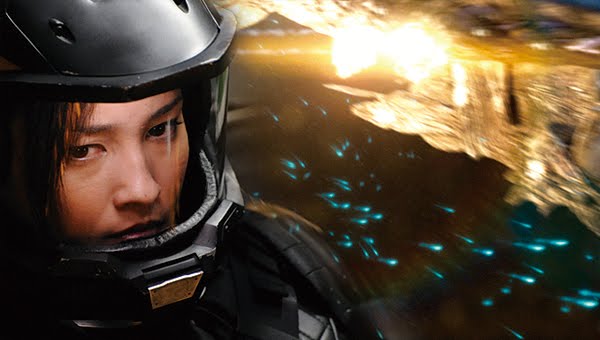SPACE BATTLESHIP YAMATO
SPACE BATTLESHIP YAMATO: Ariel Esteban Cayer takes a look at the live-action adaptation of the classic anime series
In the winter of 2010, while most blockbuster-savvy audiences had their eyes riveted on the first part of Harry Potter and the Deathly Hallows, Japanese screens were monopolized by a live-action adaptation of their own: Space Battleship Yamato, directed by Takashi Yamazaki (of the Always, Sunset on Third Street series) and written by Shimaku Sato (whose K-20: Legend of the Mask also graced the Fantasia screens). Dethroning the puny teenage wizard at the top of the Japanese box-office, Space Battleship Yamato is the first live-action adaptation of Yoshinobu Nishizaki’s beloved anime series.
Aired initially from 1974 to 1975 for a total of 26 episodes, Space Battleship Yamato has since spawned 6 animated films, 2 sequel TV series (Space Battleship Yamato II and Space Battleship Yamato III), a couple of video games, 2 OVA (original video animation a.k.a. direct-to-video anime) series and perhaps most notorious of all, a manga adaptation by the legendary co-creator and space opera maestro Leiji Matsumoto – whose work North American audiences are more than familiar with, given the immense popularity of his slender and sassy Captain Harlock, whose feathered hair, good looks and heroism stole a million young girls (and boys)’ hearts in the 1978 series Space Pirate Captain Harlock – better known in Québec as the cultissime Albator, le corsaire de l’espace. Similarly, Space Battleship Yamato was mainly known in North America as Star Blazers; its heavily edited and dubbed international incarnation which was broadcast from 1979 to 1984, encompassing all three Space Battleship Yamato series in 77 episodes Notably paving the way for serialized children’s entertainment of overarching storylines obliging that episodes be shown in strict chronological order, Space Battleship Yamato effectively rode the wave of late 70s-to-mid-80s TV adaptations of Japanese anime at the forefront of which were series like Battle of the Planets (1978-1985; chopped together from 1972’s Science Ninja Team Gatchaman), Voltron (1984-1985), Leiji Matsumoto’s generally eclipsed but similarly masterful Galaxy Express 999 (1978-1981) as well as countless others.
Following Roddenberry’s Star Trek (1966-1969), much of 2010’s Space Battleship Yamato is built on the archetypal space opera model. Telling the story of the Earth’s Defence Force’s (EDF for short) mission aboard the Yamato to retrieve a anti-radiation device at the ends of the known universe that might restore Earth to its former green glory (more specifically on the planet Iscandar), a lot of the feature film’s plot will recall 2004’s relaunch of Battlestar Galactica – from its mankind’s last hope quest scenario to its military look and set design – despite the original series having aired in 1978. That said, Yamazaki’s film more than holds its own as a post-Star Wars prequels space epic with its share of planet-shattering technologies, aliens, doomsday scenarios, bridge politics, space CGI battles levitra show pill during which you can, of course, hear the sounds of the lasers (why anyone would complain about fictitious laser sounds is beyond me) and a handful of Japanese melodrama for good measure. In terms of sheer production value and aesthetics, Yamazaki takes his cues from J.J. Abrams’ subtly trend-setting 2009 Star Trek film, propelling the viewer in a sharp, vibrant and brighter-than-life future of lens flares and alien energy glow. Adapting the crux of the anime series faithfully, Sato’s screenplay takes some liberties, giving jet pilot Yuki (portrayed by actress and singer Meisa Kuroki) a more active role – which inevitably sets up a love story with the main protagonist Kodai, who, cheapest viagra canada while no Harlock, is portrayed by Japanese poster boy Kimura Takuya, affectionately referred to by the shorthand Kimutaku. Sato also recasts ship doctor Sado and communications officer Aihara (notice the uncanny phonetic similarity with U.S.S. Entreprise’s own Uhura) as women and transforms the evil Gamilons (referred to as Gamilas in the live-action film), initially blue-skinned villains of the planet Gamilon (plat that shares its orbit with Iscandar in the original series) into a hive-minded dual race of energy beings – manifesting through crystal formations and possession of their enemies. Gamilas leader Dessler thus never appears per ser and is instead voiced by actor Masato Ibu. A modern twist that might rub purists the wrong way but that allows this film to reach a modern sensibility and credibility that blue men in outfit might’ve impeded from.
Clocking at nearly two hours and a half, Yamazaki’s film is a thorough and pleasing modernization of the anime series; allowing new audiences to discover the post-apocalyptic world of Space Battleship Yamato through epic visuals and an action-packed story that – while suffering the habitual flaws slightly overloaded blockbuster epics usually suffer from in terms of pacing and character development – proves to be highly entertaining and impressive-looking sci-fi romp that should win over space opera enthusiasts of all ages.
Space Battleship Yamato 2199, the 4th series in the franchise (rumoured to be a remake of the 1974 series comprising of 26 episodes) is scheduled to be released in Japan on April 7th 2012, the first two episodes of which will be edited together to be released theatrically. Stay tuned for more info on Canadian screenings of Space Battleship Yamato.

 April 1, 2012
April 1, 2012  No Comments
No Comments



